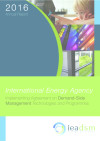Suchergebnisse
Jahresbericht 2018 des IEA Wärmepumpenprogramms

Der Jahresbericht des Technology Collaborating Programme on Heat Pumping Technologies (TCP HPT) enthält einen Rückblick auf die Highlights aus dem Jahr 2018. Im HPT liefen 2018 elf Projekte, sechs davon mit österreichischer Beteiligung.
Herausgeber: IEA TCP on Heat Pump Technologies (HPT TCP)
Englisch, 51 Seiten
IEA Wärmepumpenprogramm (HPT): Annual Report 2021

Der Jahresbericht des Technology Collaborating Programme on Heat Pumping Technologies (TCP HPT) enthält einen Rückblick auf die Highlights des Jahres 2021 und gibt einen Überblick über neue, laufende und 2021 abgeschlossene Projekte (Annexe).
Herausgeber: IEA TCP on Heat Pump Technologies (HPT TCP), 2021
Englisch, 48 Seiten
IEA EBC Annual Report 2020

Im Jahresbericht werden die neuen, die laufenden und die abgeschlossenen IEA EBC Projekte vorgestellt und über Ausgangssituation und Ziele der neuen EBC Beitrittsländer, Brasilien und Türkei, berichtet.
Herausgeber: AECOM Ltd im Namen der Internationalen Energie Agentur – Energien in Gebäuden und Kommunen
Englisch, 74 Seiten
Downloads zur Publikation
Jahresbericht 2015 des IEA Wärmepumpenprogramms

Der Jahresbericht des Technology Collaborating Programme on Heat Pumping Technologies (TCP HPT) enthält einen Rückblick auf die Highlights aus dem Jahr 2015, das für das IEA Wärmepumpenprogramm sehr erfolgreich war.
Herausgeber: IEA Heat Pump Programme (HPP)
Englisch, 24 Seiten
Downloads zur Publikation
IETS Newsletter No. 7, February 2018

Der Newsletter informiert über Neuigkeiten aus den laufenden Annexen sowie kommende Veranstaltungen und weitere Aktivitäten aus dem Programm "Industrielle Energietechnologien und Systeme".
Herausgeber: IEA IETS
Englisch, 2 Seiten
Heat Pumping Technologies Program (HPT TCP): Neue Webseite, neues Design
Das Technologieprogramm für Wärmepumpentechnologie (HPT TCP) erscheint im neuen Glanz. Mit brandneuer Webseite und Webadresse steht das HPT TCP selbst mehr im Fokus und präsentiert sich modern und mit einfacherer Usability für die NutzerInnen.
IEA DSM Annual Report 2016: Implementing Agreement on Demand-Side Management Technologies and Programmes

Die Inhalte des Jahresberichts 2016 umfassen neben den Statusbeschreibungen der aktuellen Tasks (Task 16, 17, 24 und 25) die derzeitigen Prioritäten des DSM generell und in den teilnehmenden Ländern.
Anne Bengtson
Herausgeber: IEA Demand-Side Management Programme
Englisch, 120 Seiten
Downloads zur Publikation
ISGAN Annual Report Year 5 (2015)

Im Jahresbericht für das 5. Jahr wurden neben einem organisatorischen Überblick und Entwicklungen in den Teilnehmerländern die Höhepunkte der Aktivitäten im Jahr 2015 dargestellt. Dazu gehören der ISGAN Award, Publikationen und Workshops.
Herausgeber: Korea Smart Grid Institute (KSGI)
Englisch
IEA DSM Annual Report 2017: Implementing Agreement on Demand-Side Management Technologies and Programmes

Die Inhalte des Jahresberichts 2017 umfassen neben den Statusbeschreibungen der aktuellen Tasks (Task 16, 24 und 25) die derzeitigen Prioritäten des DSM generell und in den teilnehmenden Ländern.
Anne Bengtson
Herausgeber: IEA Demand-Side Management Programme
Englisch, 85 Seiten
Downloads zur Publikation
IEA EBC Annex 63: Volume 0 - Documentation of workshops and involvement of cities (2017)

Dieser Bericht gibt einen Überblick über die im Rahmen des Projekts Annex 63 durchgeführten Workshops.
Helmut Strasser et al.
Herausgeber: IEA EBC Annex 63
Englisch, 49 Seiten
IEA EBC Annex 63: Volume 1 - Inventory of measures (2017)

Dieser Bericht gibt einen Überblick über die im Rahmen des Projekts Annex 63 analysierten städtischen Planungsprozesse und "Maßnahmen".
Ken Church et al.
Herausgeber: IEA EBC Annex 63
Englisch, 49 Seiten
IEA EBC Annex 63: Volume 2 - Development of strategic measures (2017)

Dieser Bericht gibt einen Überblick über die im Rahmen des Projekts Annex 63 erarbeiteten "strategischen Maßnahmen".
Daniel Kellenberger
Herausgeber: IEA EBC Annex 63
Englisch, 251 Seiten
IEA SHC Task 61/EBC Annex 77: Ganzheitliche Lösungen für Tages- und Kunstlicht
Auf die Beleuchtung entfallen etwa 15 % des weltweiten Stromverbrauchs - eine intelligente Abstimmung von Tageslicht- und Kunstlichtlösungen sowie integrale Lichtsteuerungen ermöglichen wesentliche Energieeinsparungen. Gleichzeitig müssen die Lösungen Nutzer:innen-zentriert anhand der visuellen und biologischen Lichtwirkungen optimal geplant werden. Im Task wurden Nutzerinnen-Anforderungen sowie existierende Technologien und Planungsmethoden analysiert und exemplarische Umsetzungen in Fallstudien dokumentiert.
IEA SHC Task 61/EBC Annex 77: Integrated Solutions for Daylighting and Electric Lighting
Lighting accounts for around 15% of global electricity consumption - intelligent coordination of daylighting and electric lighting solutions together with integral lighting controls enable significant energy savings. At the same time, the solutions must be optimally planned in a user-centered approach based on the visual and non-visual effects of light. The task analysed user requirements as well as existing technologies and design methods and documented exemplary implementations in case studies.
IEA SHC Task 59/EBC Annex 76: Ganzheitliche Sanierung von historischen Gebäuden
Ziel von Task 59 war die Dokumentation von internationalen Best Practice Beispielen (Knowledge Base), Entwicklung eines multidisziplinären Planungsprozesses sowie die Entwicklung von ganzheitlichen Sanierungslösungen für historische Gebäude. Als Knowledge Base ist aus diesem Projekt der Historic Building Retrofit Atlas (www.HiBERatlas.com) entstanden, in dem mehr als 50 Best Practice Beispiele dokumentiert sind. Neben der Leitung von Subtask A (Knowledge Base) und Subtask C (Conservation compatible retrofit solutions & strategies) sind durch die österreichische Beteiligung innovative technische und organisatorische Sanierungslösungen eingeflossen und weiterentwickelt worden, die bereits in nationalen Demonstrationsprojekten angewendet und in der Praxis erprobt wurden.
IEA SHC Task 59/EBC Annex 76: Deep Renovation of Historic Buildings - Towards lowest possible energy demand and CO2 emission (nZEB)
The goal of Task 59 was to document international best practice examples (knowledge base), develop a multidisciplinary planning process, and develop holistic retrofit solutions for historic buildings. As a knowledge base, the Historic Building Retrofit Atlas (www.HiBERatlas.com) emerged from the project. In the HiBERatlas more than 55 best practice examples are documented. In addition to the management of Subtask A (Knowledge Base) and Subtask C (Conservation compatible retrofit solutions & strategies), innovative technical and organizational retrofit solutions, which have already been applied in national demonstration projects and tested in practice, have been incorporated and further developed through the Austrian participation.
IEA DSM Spotlight-Newsletter 67, Jänner 2018

Der aktuelle Newsletter befasst sich mit der Rolle der Blockchain-Technologie für den Peer-to-Peer Energiehandel, einem Programm zur Steigerung der Energieeffizienz in Indien sowie mit Updates aus dem IEA DSM Task 17.
Herausgeber: IEA-DSM, 2018
Englisch, 13 Seiten
Downloads zur Publikation
IEA HEV TCP Task 40: Kritische Rohstoffe für Elektrofahrzeuge
Die Herstellung von Elektrofahrzeugen und Batterien benötigt kritische Rohstoffe. In Task 40 werden Bedarf und Angebot gegenübergestellt auf Basis von globalen Szenarien der Entwicklung von Elektrofahrzeugflotten, von Batterietechnologien, von primären und sekundären Rohstoffpotentialen und von Recyclingtechnologien. Potentielle gesamthafte ökologische und soziale Auswirkungen der Rohstoff- und Batterieproduktion werden bewertet.
IEA HEV TCP Task 40: Critical Raw Materials for Electric Vehicles
The production of electric vehicles and batteries requires critical raw materials. In Task 40, demand and supply are compared, based on global scenarios of the development of electric vehicle fleets, battery technologies, primary and secondary raw material potentials and recycling technologies. Potential overall ecological and social impacts of raw material and battery production are assessed.
IEA HEV TCP Task 49: Electric Vehicle-Fire Safety
As the number of electric vehicles increases, so does the need for safety. The project is creating an overview of fire safety standards for electric vehicles and networking relevant stakeholders. Challenges are discussed and experiences exchanged in national and international expert workshops. The focus is on promoting the safety of electric vehicles and increasing their acceptance.
